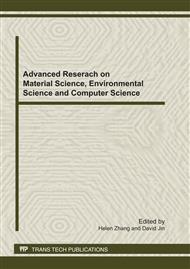p.108
p.112
p.116
p.120
p.125
p.129
p.134
p.139
p.144
Sorption and Desorption of DDTs to Natural Surface Coatings
Abstract:
The sorption/desorption of DDTs to surface coatings were investigated using the bath equilibration technique. Freundlich isotherm was applied to describe the sorption/desorption of DDTs to surface coatings. The results showed that desorption of DDTs from surface coatings presented hysteresis which was described by hysteresis index (HI). Influences of pH values of solutions and the coexistence of Cu and Pb on sorption and desorption were also studied in the same method. The results indicated that the sorption of DDTs decreased and desorption increased when the values of pH increased from 5 to 9. The coexistence of Cu and Pb inhibited the sorption of DDTs, meanwhile had facility to desorption of DDTs.
Info:
Periodical:
Pages:
125-128
Citation:
Online since:
August 2011
Authors:
Keywords:
Price:
Сopyright:
© 2011 Trans Tech Publications Ltd. All Rights Reserved
Share:
Citation:


